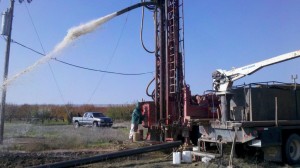
Water well Pressure tanks
Water pressure tanks are just one of the items needed to have water for your home from your water well. The purpose of the pressure tank is to insure your system always has constant pressure and decreases the number of times your pump has to cycle on and off. The water is regulated by the pressure switch which should have a 20 lb span. It also insures you get at least one minute of total run time (two minutes for pumps larger than 3 HP) so the submersible motor can properly be cooled by the well water running across it. This is why properly sizing a pressure tank to the water output of your pumping system is crucial to insure longevity of the submersible pump and motor.
Water, unlike air, cannot be squeezed or compressed into a smaller volume. A pressure tank has air that is compressed by the rising water level in the tank as a means for storing energy. The compressed air resides at the top of the pressure tank and acts like a coiled spring. This in turn pushes down on the water at the bottom of the tank. When a fixture or faucet in the system is opened, the air pressure at the top of the tank forces the water to flow out of the tank (drawdown) and into the system delivering water to the fixtures calling for it.
The pressure in the tank will then drop below the preset pressure range set by your pressure switch, that allows the pump to kick on to provide the system with continued water flow. The pump continues to deliver water under the pressure of the tank. As the tank refills, the air over the water is being compressed readying itself for the next call for water. If no water is being used then water will continue to enter the tank until the appropriate amount of water is in the tank. When the call for water ceases, the pressure switch will kick off and the pump then stops.
Pressure tanks are set up to be 2/3 air and 1/3 water. For example: You have a 22 gallon tank which means the actual holding capacity (in terms of water) would be 7.3 gallons. This (in the event of power loss) does not give you a lot of water to work with. Most typical residential applications call for a minimum of a 25 useable gallons of water in your pressure tank.
Troubleshooting tank issues can be fairly easy for the typical handy man homeowner. It’s always good to remember the (2/1 ration 2/3 air 1/3 water) the top 2/3 of the tank should sound hollow when tapped with knuckles on the side of the tank. If this is not the case than calling for service would be recommended.
*PSI stands for pounds per square inch of pressure

